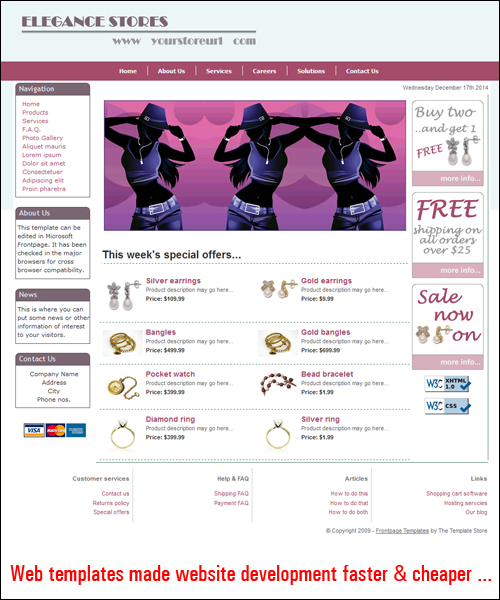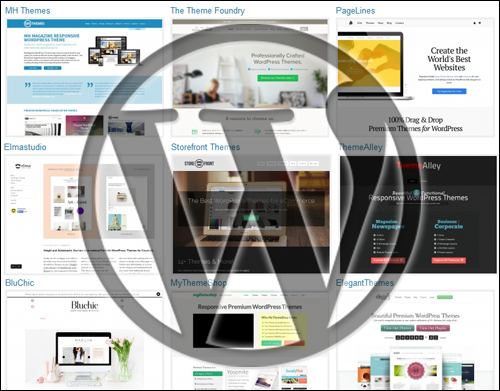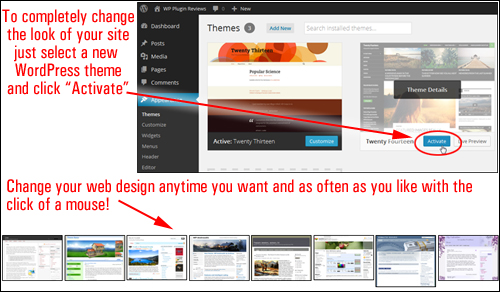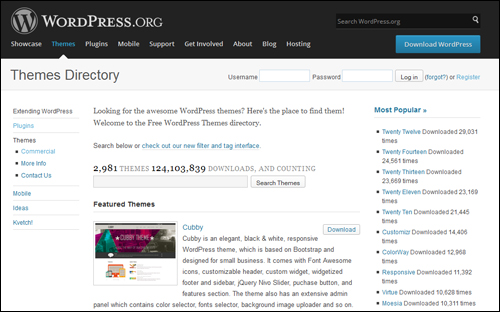 Advanced web site publishing technologies like the WordPress Content Management System (CMS) have effectively simplified web design and web development for anyone wanting to start a website.
Advanced web site publishing technologies like the WordPress Content Management System (CMS) have effectively simplified web design and web development for anyone wanting to start a website.
This greatly benefits businesses planning to start a website that is simple, easy and inexpensive to manage.
Before blogging and the introduction of powerful and simple CMS applications, if you needed a website, you normally had to wait until both the web development and web design processes were completely done. This could mean waiting around for weeks, even many months!
The introduction of WordPress themes have changed all this. In this article, you will learn what themes are, how they save you money on website design costs, and how WordPress themes allow you to easily customize your website.
Website Design Revolution
Businesses will benefit from an evolution in web design that began shortly after websites were first introduced. If you are a small business owner, you will want to know more about this, because it can save you a lot of time and money on web development or web design costs.
Let’s briefly go over what normally happened before tool like WordPress was introduced:
First, you would discuss your project with a web developer or web designer. Then, the “web design” itself would be decided upon. This required time being spent with someone with website design skills discussing areas of the web site like the layout, colors, styles, graphic elements, content, etc.
Each page of your site then had to be hand-coded with the elements and scripts coded into your content. All pages were then assembled together into a website using links and custom coded navigation menus and uploaded to your server, together with every other file needed to make your website work – script libraries, graphic images, media elements, etc.

(image source:adobe.com)
Only after everything had been tested and performed how it was supposed to (and looking how a client had imagined it to look), was the site considered to be finished and ready to go live.
The next step in the evolution of business website design was the introduction of “web templating elements”. A web site template allows the design of the website to be worked on separately from the page content. Having templates helped to make the process of web site development faster and resulted in lowered costs of production. This also allowed website development firms to work with businesses with smaller marketing budgets …

(image source: www.dreamweaver-templates.org)
As more web development companies started using “template-based” websites, templates started being created that offered different customizable features, like color palettes, the ability to select different menu styles, formats, header, footer and navigation elements, layouts, and so on.
As websites and web editor tools evolved, website templates also began to transform into website templating ”systems”, letting users manage the visual components of a website.
Then, a “blogging” software called WordPress came along and helped to start a new content management revolution …

(WordPress – A Content Publishing Revolution)
To learn more about content management systems and the benefits of the WordPress CMS, see the tutorial below:
About WordPress Themes
WordPress themes expand the concept of a web templating system one step further.
A WordPress theme controls all of the design elements of a web site. It lets you add a “skin” to your site much like a template system does but also provides you with complete control over the management, presentation and customization of your site’s template features.
As explained in the official WordPress site …
A WordPress Theme is a collection of files that work together to produce a graphical interface with an underlying unifying design for a weblog. These files are called template files. A Theme modifies the way the site is displayed, without modifying the underlying software. Themes may include customized template files, image files (*.jpg, *.gif), style sheets (*.css), custom Pages, as well as any necessary code files (*.php).
(source: WordPress.org)
As the above quote states, one of the unique features of the WP theme is that how your site appears to visitors does not affect the way your website is configured in the backend to handle areas like content management and functionality.
Basically, what this means is that a theme lets you change the design of your website as often as you want without affecting your website’s content and all the functionality you’ve built into it. For example, if WP website has been set up for e-commerce, changing the entire look of the site with another theme won’t affect the content or the functionality of the site. All e-commerce features, site and plugin settings and product information will remain unaffected, but your site will look completely different.
This is important. Why?
Because when you use WordPress, you no longer need to spend weeks or months waiting for your site to be done. You can get your business website built quickly and start with any theme you want, and change the entire look, feel and design of your WordPress site in minutes, whenever you want … and as often as you like!
Even better, you can easily replace any theme on your WordPress site without requiring website coding skills. Simply pick any WP theme you like, install it on your site and activate it. WordPress lets you change your entire site’s web design and customize elements like header images, page layout, typography and more in a few seconds …

As WordPress is distributed as open source software, web design companies can create themes specifically for the WordPress platform using the WordPress template system.
This means that thousands of high quality WordPress themes are made available to WordPress users. Themes are normally distributed for FREE under the terms of the GNU License Definition, or sold as Premium (paid) WP themes.
The WordPress development team maintains a FREE theme directory which gives WordPress users access thousands of excellent WP themes at $0 cost …

(WordPress.org – WP Themes Directory)
As the popularity of WordPress increases, more designers are now starting to create themes for a wider audience of web users.
Themes vary from professional-looking, to quirky designs that are simply beautiful and would typically cost thousands of dollars to commission. Surprisingly, most themes can be bought quite inexpensively, especially when you compare the cost to what you would have been charged if a web designer had to create it from scratch.
You can see a number of WP theme galleries that include various examples of great premium themes in this post:

(Browse Thousands Of FREE WordPress Themes!)
Benefits And Advantages Of Themes
Here are just some of the benefits of choosing WordPress themes over using traditional web template design:
Be Up And Running In Minutes
WP themes are very easy to install on your site. Just upload a zip file that contains the plugin to your Plugin folder via your admin user section and activate. Even easier still, you can install any of the themes listed in the WP themes repository at WordPress.org) directly inside your WordPress site’s admin area.

Additionally,
- WordPress has a large online community of commercial web developers and development companies who contribute thousands of great WP Themes available to users. Thousands of these themes are completely free to use!
- Themes give sites a consistent look across all your blog’s elements, i.e. pages, headers, footers, layouts, etc …
- A “theme” works independently of your site’s content. This allows you swap the “look and feel” of your site as often as you like without deleting the settings.
- Many WordPress themes provide additional built-in functionality and settings that let you easily customize the theme’s layout, style and design properties and create a unique look to suit your needs.
- Many WP themes are built using a framework that allows you to update themes to newer versions without losing its unique customizations (e.g. styles)
- WordPress allows you to search, import, install and update WordPress Themes automatically right inside the dashboard.
- WP themes lets you save thousands of dollars on web development costs. Free themes cost nothing and most “Premium”themes are normally very inexpensive.
Responsive WP Themes
Many theme designers are now developing “responsive” themes.
A responsive theme allows a website to automatically readjust the web layout to display smoothly over different monitor sizes and screen resolutions, as well as different platforms) …

Responsive themes are also optimized for each device type. Users can navigate, read and display the site on different devices without having to resize anything, or requiring the website owner to have installed additional display elements.
Note: When searching for WordPress themes, we recommend choosing a responsive WordPress theme. Not only will the theme ensure that the content and layout of your site will display correctly across all of your visitors’ devices, but it also means that the theme is newer than non-responsive themes and therefore should comply with the latest standards, practices and techniques of web design coding.
Hopefully, the above article has provided you with a clearer overview of themes, what WP themes are, how WordPress themes can help you save money, and how WP themes make customizing sites easy.
In our next blog post on basic WordPress features, we show you where to find the best themes for your website or blog.
***
"Learning WordPress has been a huge stumbling block for me. I've been looking for something that covers absolutely everything but doesn't cost an arm and a leg. Thank you so much ... you have just provided me with what I have been looking for! Truly appreciated!" - Tanya
***